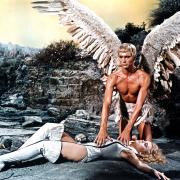The mayfly are hatching this month leading both trout and anglers a merry dance. Simon Cooper explores this extraordinary natural phenomenon and where to cast your line

For a month, starting in the middle of May, trout go on a feeding frenzy, gorging themselves on the millions of emerging mayfly. Each mayfly, the size of a dandelion head, represents breakfast, lunch and tea all rolled into one for the hungry trout.Undeniably beautiful with their large white wings and delicate segmented body, the mayfly alight on the surface of the river and drift downstream like little sailing boats. Their long tails, the length and shape of a cat’s whiskers, curl up from the water to balance them in the ripple and prevent the breeze tipping them over.

Having completed their spectacular aerial mating dance beside the river, at this point our female, Ephemera danica, has just 24 hours to live. During this time she must ensure the survival of the next generation by depositing tens of thousands of microscopic eggs into the water. The long lines of sticky ova, just slightly denser than water, drift down on the current until they become lodged on the riverbed. There they begin a two-year cycle that takes them from egg to larvae, to water nymph before emerging as mayfly one glorious May day.
Even the death throes of the mother creates an opportunity for trout and angler alike - dying insects are easy pickings. For the angler, spotting what the trout are eating means they can tie on the suitable imitation fly, in this case the ‘Spent Mayfly’. And herein lies the fascination of mayfly fishing for the angler. At most times of the year the insects trout consume are tiny, but during the mayfly season everything is big: the size of the insects, the appetite of the fish and the enthusiasm of the angler.
From mid-May to mid-June clouds of mayfly drift like gunsmoke across the Dorset chalkstreams of the Allen, Frome and Piddle. This natural spectacle is infuriatingly elusive - sometimes you have to wait until late afternoon, other days it will be mid-morning. Equally infuriating are the fickle fish. There are dozens of different mayfly patterns to choose from. One day you will knock ‘em dead with a White Drake, the following day only a Green Drake will do.
But that is the joy of mayfly. You’ll be on a river, in the midst of an entomological phenomenon, trout rising hither and thither, and you’ll be all fingers and thumbs in the excitement of tying on your fly. But in the end you will work it out and the success will be all the sweeter for it.
Where to Cast Your Line
Dorset has a huge variety of trout fishing on both lakes and rivers. The season runs from April 3rd to October 31st on rivers and all year on lakes. To fish you will need to purchase a day ticket from the fishery owner. In addition you must be in possession of an Environment Agency fishing licence, buy from any Post Office or on-line (environment-agency.gov.uk)
River Allen: Fishing Breaks have a wide selection of the best chalkstreams in southern England. Day tickets start from £50/day (fishingbreaks.co.uk)
River Frome: Oliver Pope at Wrackleford Estate has many miles of lovely beats north of Dorchester. From £65/day (wrackleford.co.uk)
Wessex Fly Fishing: Trout lakes at Tolpuddle. Day tickets from £18
(goflyfishing.co.uk)
Simon Cooper is the Founder of Fishing Breaks, a leading agent for chalkstream fishing, he also runs fly fishing courses. For more details call 01264 781988 or
visit fishingbreaks.co.uk



























